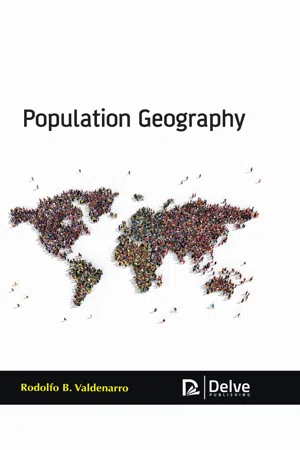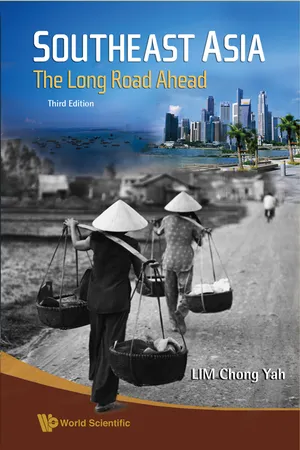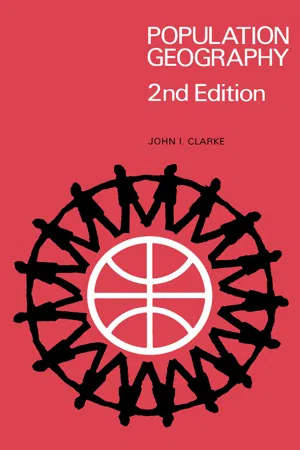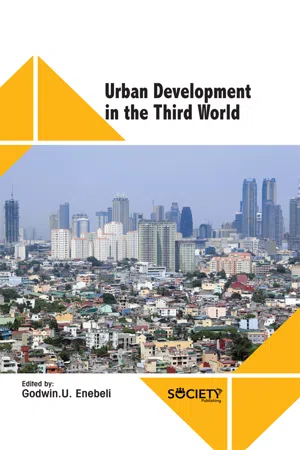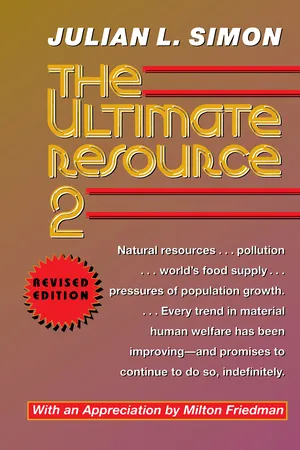Geography
Rapid Population Growth
Rapid population growth refers to a significant increase in the number of people within a specific area over a relatively short period of time. This can lead to various social, economic, and environmental challenges, including strain on resources, urbanization, and pressure on infrastructure. Managing rapid population growth is a key concern for policymakers and planners in many regions around the world.
Written by Perlego with AI-assistance
Related key terms
1 of 5
10 Key excerpts on "Rapid Population Growth"
- Chandrika Kaul, Valerie Tomaselli-Moschovitis, Chandrika Kaul, Valerie Tomaselli-Moschovitis(Authors)
- 1999(Publication Date)
- Greenwood(Publisher)
Population Growth Rates: Growth rates in popu- lation show the change over a designated period of time in the size of a country's population. For the students and policymakers concerned with poverty, they are a cru- cial indicator of the pressure exerted on a country's natu- ral, economic, and social resources (health care and education, for instance). Controlling rapidly accelerat- ing growth rates is one of the primary concerns of policymakers in developing countries (D2.1-D2.3). Population Density: As a measure of the number of people per unit of land area, population density is one of the most basic indicators of the human pressure on natural resources. As population growth rates (see above) accelerate—and the land area of a country remains the same—population density increases. Increasing pressure on existing land resources may engender health and en- vironmental concerns, such as inadequate food supply and unhealthy sanitation, if the growth of appropriate infrastructure lags behind (D3.1-D3.3). Rural Population Density: The rural component of population density helps analysts and students moni- tor the potential population pressure on rural communi- ties. This demographic pressure is important, as some rural environments are already strained to accommodate existing populations, and accelerating rural population density trends indicate potential increased threats to the survival (outstripping of food supply, for instance), health concerns, and infrastructure in these communities (D4.1- D4.4). Urban Population and Growth Rates: Often in de- veloping countries, urban population growth rates are higher than those in rural areas and continue to acceler- ate at an astronomical rate, as economic needs push people towards centers of population where economic opportunity is most often the highest.- eBook - PDF
- Rodolfo B. Valdenarro(Author)
- 2020(Publication Date)
- Delve Publishing(Publisher)
Figure 8.4. Population growth is currently one of the most serious threats to human happiness and progress and that it is a threat to all our efforts to raise our living standards. Source: https://citizentv.co.ke/news/africas-rapid-population-growth-puts-pov-erty-progress-risk-gates-212363/. Some scholars argue that unless population grows is restrained, we may have to abandon for this generation our hopes of economic progress. Progress may not be feasible with the current rate of population increase. Rapid Population Growth slows down the growth of per capita incomes in less developed countries and tends to perpetuate inequalities of income distribution. It holds down the level of savings and capital investment in Population Geography 200 the means of production thereby limiting the growth rate of gross national product. In total agreement with the foregoing, past scholars observed that countries which are now in the developed category, population growth and economic growth usually went together but an opposite in developing countries. In these countries, Rapid Population Growth increases the dependency burden thereby reducing the ability of the working population to save. This, in turn, makes it difficult to create the necessary capital to productively employ the growing population. The picture which emerges here is that population growth perpetuates the vicious cycle of poverty. In the long-run, the course of economic development is inextricably bound up with changes in the size and composition of the population. In addition to the foregoing, many statements have been made by leading personalities on the population question. One reason for this is their realization that population growth is one factor which is capable of thwarting development (Gould, Population, and Development, 2015). - eBook - PDF
Southeast Asia
The Long Road Ahead
- Chong Yah Lim(Author)
- 2009(Publication Date)
- WSPC(Publisher)
Key Points 1. Notwithstanding the slowing down of population growth rates in Southeast Asian countries, the rate of growth in the region is faster than the world average. Possible explanations include a lower crude death 11. Population Explosion and Characteristics ■ 335 rate due to longer life expectancy and better healthcare facilities. Another reason is the declining of infant mortality rates. 2. A Rapid Population Growth without an equivalent growth in national income leads to a lower standard of living. Furthermore, countries experiencing population explosion may suffer from the vicious cycle of the low-level equilibrium trap. When per capita income is low, the savings rate will be low. This leads to a low investment rate. With a low investment rate, the rate of growth will thus be low. 3. Another implication of Rapid Population Growth is on unemployment. The most serious form of unemployment is Ricardian unemployment, which occurs when labour supply is too excessive in relation to other complementary factors of production. However, declining fertility rates can also cause problems, as in the case of Singapore, it affects future labour participation rates. 4. Besides having optimum population size and growth, a country should also invest in the development of human resources. Through education, the productive capacity of the labour force will improve. Although universal primary education is achieved in most Southeast Asian countries, there are still great differences in the secondary and tertiary education among countries in the region. Nearly all the countries have standards well below those of the developed countries, either in quantity or in quality or both. 5. A common phenomenon in countries with a dualistic economy is internal migration, i.e. people move from rural to urban areas. The main reason is to seek employment. - eBook - PDF
Biology Today
An Issues Approach
- Eli Minkoff, Pamela Baker(Authors)
- 2003(Publication Date)
- Garland Science(Publisher)
To include migration rates in the calculation of r , we must write r = B – D + i – m where i is the rate of immigration (the number of immigrants in a year divided by the population size) and m is the similarly defined rate of emigration. Figure 9.2 (A) Population growth rates ( r ) and (B) population densities around the world. 0–9 10–25 26–49 50–99 100–299 300 or above people/square mile (B) POPULATION DENSITY <0 0.00–0.99 1.00–1.99 2.00–2.99 3.00–3.99 4.00–4.99 5.00 or above annual growth rate (%) (A) ANNUAL GROWTH RATES w w w Chapter 9: The Population Explosion In most nations today, population growth results mostly from the excess of births over deaths rather than from the excess of immigration over emigration. In the 1990s the U.S. population seemed to have reached a balance between birth and death rates. More recently, however, the birth rate (about 1.8% annually, or one birth every 7 seconds) has increased to about twice the death rate (about 0.9% annually, or one death every 14 seconds), and there also continues to be an excess of immigration over emigration. The net change is a population increase of one person approximately every 11 seconds in the United States. Many factors, some of them perhaps temporary, have contributed to the recent changes. For example, many ‘baby boomers’ (people born between about 1945 and 1960) began having additional children many years after they first became parents, and there have also been increases in the number of people remarrying and starting second families. Exponential (geometric) growth. Although the definition of the term r may include immigration and emigration, the overall equation for the growth rate has not changed, and remains dN / dT = r N The type of growth described by this equation is an example of geomet-ric growth. A geometric series is one in which each number is multiplied by a constant to produce the next number in the series. - eBook - PDF
Population Geography
Pergamon Oxford Geographies
- John I. Clarke, W. B. Fisher(Authors)
- 2013(Publication Date)
- Pergamon(Publisher)
C H A P T E R Χ POPULATION G R O W T H THE reason for calling this chapter Population Growth rather than Population Change is that at national level very few populations are declining. Most are growing so rapidly that world population growth is one of the major problems of the present. On the other hand, within developed countries there are usually many districts experiencing population decUne. Measures of Population Growth and Replacement Apart from the absolute increase or decrease per annum, one of the most common measures of growth is the annual rate of increase. The U.N. Demo-graphic Yearbooks use the foUowing formula: X 100 where PQ is the population at the beginning of the period. Pi is the population at the end of the period, and t is the number of years. The two main components may be census returns or population estimates, and so the rate is subjea to the general quaUfications for such data. It is a useful rate, and may be helpful in assessing the accuracy of vital and migration statistics. Natural increase is the positive difference between the numbers of births and deaths, and the natural increase rate is the difference between the crude birth and death rates; natural decrease and natural decrease rates are negative differences, but they are less common, except in rural areas of developed countries. A natural increase rate may also be calculated by subtracting deaths from births and dividing by the population total for a specific year. Despite its widespread use, this rate expresses population growth very imperfectly, as it ignores the ageing of each individual diuring the year and does not differentiate between the deaths of old and young persons. In other words, natural increase rates ignore age-composition, so a population with a high proportion in the reproductive age-groups might have a positive natmral increase rate and yet experience low fertiUty and lack of replacement. - eBook - PDF
- R. Knowles, J. Wareing(Authors)
- 2014(Publication Date)
- Made Simple(Publisher)
At present rates the population of these countries will double within 25 years. Tropical Latin America requires immediate population con-trol before the problems of overpopulation become too deep-rooted and the crisis of the Far East is duplicated there. Population Growth: Attitudes and Interpretations The various interpretations and theories of population growth have been divided into three broad categories: biological, cultural and economic. Biological theories suggest that the influences on human population growth are essentially the same as those regulating the growth in numbers of plants and animals. It has been argued, for example, that fertility diminishes and is regulated by increasing population density. Cultural theories, on the other hand, regard demographic growth as unique and emphasise the importance of man's reason and intellect in influencing his growth in numbers. The declin-ing birth rates of the economically advanced nations are seen as evidence of man's ability to control his growth in numbers. Economic theories, especially those of Marxist-Leninist economists, emphasise the importance of economic factors, notably the demand for labour, as being the essential influences on growth rates, patterns of migration and population distribution. Thomas Robert Malthus Any comments on the interpretation of population growth must inevitably make mention of the writings of the Reverend Thomas Malthus (1766-1834). Malthus first expounded his ideas in his Essay on the Principle of Population, published in 1798. He was convinced that man would always be faced with the basic problem that his numbers increase more rapidly than food production. - eBook - PDF
- Godwin .U. Enebeli(Author)
- 2020(Publication Date)
- Society Publishing(Publisher)
5.1. INTRODUCTION The elevation in the growth of the population (that is based on per hundred), several numbers of people who are living in a particular given area over a given interval of time. In conflict to this, urbanization has dawned a new era on the world. It has concentrated the population to particular area. In general, it means that the process of urbanization takes place in two different ways. First is the multiplication of the point of concentration, while the second method is the increase in the size of the concentration of the population (Tisdale, 1941). The process of the Urbanization can be deliberated in two various traditions. First of all, one is the level of urbanization (which is the existing case of a particular region at any particular point of time). The second tradition is rate of the process of the urbanization that refers to the “trend of the urban development” (UN, 1974) (Figure 5.1). Typically, the raise in the specific segment of urban population is called “urbanization.” The process of the urbanization can be identified with the help of three factors. These three aspects or factors are known as natural growth, second is the reclassification of the areas from rural region to the urban region, and last but not the least is rural-urban migration. This process takes place because of the intensification of the human activities which is consisting of both industrialization as well as marketization. Role and Impact of Population in Urban Development 119 Figure 5.1. Role and impact of the population on urban development. Source: Image by Wikimedia Commons. It is anticipated that by the time period of 20 th century, a third of the world’s population will be living in the urban area with high rate of demographic expansion and the rural-urban migration. Over 3 billion people will be residing in these cities, more particularly in the regions of Asia and Africa (Buhaug and Urdal, 2013; Pham et al., 2011; UNHABITAT, 2010). - eBook - PDF
- Adam Szirmai(Author)
- 2015(Publication Date)
- Cambridge University Press(Publisher)
Rapid growth results in a young labour force, which is often seen as a demographic window of opportunity. But, other countries with Rapid Population Growth show slow growth or even declines of per capita income. The poorest countries in Sub-Saharan Africa are the countries with the highest rates of population growth. In both the political debate and in the empirical scienti fi c discussion the contours of a new consensus have become visible: very rapid growth of population can seriously exacerbate existing economic problems in very poor societies. But these economic problems are usually not primarily caused by population growth. Therefore population policy should not be discussed in isolation. Rather it should be integrated into a wider framework of policies aimed at overall economic and social development (Bengtsson and Gunnarsson, 1994 ; Keating, 1993 , Chapter 5; United Nations Population Division, 1994 ). At the macro-level the question of controlling the growth of global population is becoming increasingly urgent in the light of issues such as global warming and global pollution (IPCC, 2007a ; Nordhaus, 2007 ; Raupach et al ., 2007 ; Stern, 2007 ; Tol, 2009 ; World Bank-WDR, 2010 ). Here, Malthusian concerns are justi fi ed. 5.3 Growth of world population ................................................................................. Table 5.1 presents estimates of world population in the very long run. This table shows that there has always been some measure of global population increase, even in pre-historic times. There was no such thing as a Malthusian equilibrium in which world population remained stable due to the checks of famine and disease. There was extensive growth , with increases in production sustaining a growing population. However, the growth of population before 1750 was very slow. After this date there was a dramatic acceleration of growth, which 162 Socio-Economic Development - eBook - PDF
Human Geography
People, Place, and Culture
- Erin H. Fouberg, Alexander B. Nash, Alexander B. Murphy, Harm J. de Blij(Authors)
- 2015(Publication Date)
- Wiley(Publisher)
The example of India shows us that internal political, social, and technological changes can influence TFR at the local level. • The demographic transition model reflects the changing demographic patterns noted in Great Britain and much of Europe from the 18th century to the present day. It demonstrates how technological and social changes impact population growth and decline. However, it would be unwise to presume that all countries will follow this model. MAIN POINTS 4.2 Why Do Populations Grow or Decline in Particular Places? 4.3 How Does the Geography of Health Influence Population Dynamics? Understanding the nature of a country’s population requires much more than simply knowing the total population or the growth rate, densities, distribution, and composition. Also of significance is the welfare of the country’s people across regions, ethnicities, or social classes. Among the most important influences on population dynamics are geographical factors. Location— that is, where one lives and works—influences access to health care, availability of clean water and good sanitation, prevalence of diseases, and quality of housing, nutrition, and education. It is important to consider how different groups, from the elderly to the disabled, experience their everyday geographies. For example, the Guest Field Note by Nicole Yantzi illustrates how geography affects and is experienced by those with chronic ill- nesses and disabilities. INFANT MORTALITY One of the leading measures of the condition of a country’s population is the infant mor- tality rate (IMR). Infant mortality records the death of babies during the first year of life. Child mortality records death be- tween ages one and five. Infant mortality is usually given as the number of deaths per thousand for every thousand live births. Infant and child mortality reflect the overall health of a society. High infant mortality has a variety of causes, the physical health of the mother being a key factor. - eBook - PDF
- Julian Lincoln Simon(Author)
- 2020(Publication Date)
- Princeton University Press(Publisher)
Summary Population growth is responsible for great improvements in the social infra-structure, especially in the transportation and communications systems that are crucial to economic development. Growth also gives a boost to agricultural saving. Population growth may or may not reduce nonagricultural saving; this is still a matter of scientific controversy. For readers who wish more detail, chapters 2, 3, 10, 11, and 12 in my technical 1977 book cover the effects of population growth on capital. 364 CHAPTER 25 6 FRINGE MINUTES PER WEEK 6 DAYTIME MINUTES PER WEEK 6 LATE EVENING MINUTES PER WEEK 1-21-4 1 -6 1 -81-101-121-141-161-181-201-20 40 60 80 100 120 140 160 180 200 220 TV MARKETS RANKED BY SIZE (FROM LARGE TO SMALL) Figure 25-2. Spot TV Costs per 1,000 Homes by TV Market Size Afternote A Parable of Population Growth, Racquetball, and Squash THIS PARABLE was written in 1980. Nothing in it has needed change except the last paragraph. There are twenty-three wonderful handball-racquetball courts on the Ur-bana campus of the University of Illinois, and seven excellent squash courts, in addition to a batch of old courts. The new racquetball courts are frequently crowded nowadays, though not so badly that people complain a lot. From time to time, however, players worry about the future growth of the univer-sity, saying that it is going to be tough to get a racquetball court. And I have heard people argue against increasing the number of students for that reason. The racquetball court situation exemplifies the country's situation with re-spect to population growth and the supply of capital. If there come to be more people, there will immediately be an increased demand for the courts. It will also be harder to find parking space, and perhaps a job. That is, the immediate effect of an increase in population is an increase in congestion.
Index pages curate the most relevant extracts from our library of academic textbooks. They’ve been created using an in-house natural language model (NLM), each adding context and meaning to key research topics.

